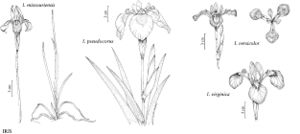Iris pseudacorus
Sp. Pl. 1: 38. 1753.
Rhizomes pink, freely branching, producing extensive clumps, 2–3 cm diam., with fibrous remains of old leaves; roots fleshy. Stems usually 1-branched, solid, 7–15 dm. Leaves: basal deciduous, at first erect, then recurved, blade dark green, with prominent median thickening, 4–10 dm × 2–3 cm, slightly glaucous basally; cauline equaling inflorescence unit. Inflorescence units 4–12-flowered; spathes green with brown margins, outer spathe strongly keeled, inner without keel, 6–9 cm, subequal, margins not scarious. Flowers: perianth bright yellow; floral tube 0.6–0.8 cm, with no constriction into ovary; sepals bright yellow or cream colored, lanceolate to ovate or suborbiculate, 5–7.5 × 3–4 cm, base abruptly attenuate, claw ca. 1/2 length of limb, signal a darker yellow basal patch limited by short, brown lines; petals without veining, lanceolate to spatulate, 2–3 cm; ovary triangular in cross section with concave sides and narrow groove at each angle, 1.5 cm; style keeled, 3–4 cm, crests spreading, 1–1.2 cm, laciniate at apex; stigmas rounded with prominent tongue; pedicel 2.5–7 cm. Capsules prismatic to oblong-ovoid, obscurely 3-angled with obvious groove at each angle, 3.5–6 cm, beak 5 mm. Seeds D-shaped, flattened, 6–7 mm, corky, lustrous. 2n = 34.
Phenology: Flowering Apr–Jun.
Habitat: Swamps, wet shores of rivers and lakes
Distribution
Introduced; B.C., Man., N.B., Nfld. and Labr. (Nfld.), N.S., Ont., P.E.I., Que., Ala., Ark., Calif., Del., D.C., Fla., Ga., Ill., Ind., Iowa, Kans., Ky., La., Maine, Mass., Miss., N.H., N.Y., N.C., Ohio, Pa., R.I., S.C., Tenn., Va., Wash., W.Va., Eurasia, n Africa.
Discussion
Selected References
None.
